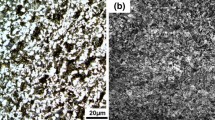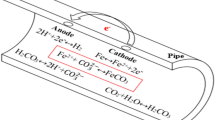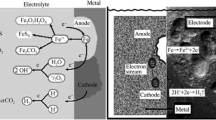Abstract
“Acid Gases” refer to two of the undesirable by-products of oil and gas, namely CO2 and H2S\(.\) The reaction of H2S and other sulphur compounds with water increases the degree of “sour corrosion” by forming sulphuric acid. CO2 corrosion of carbon and alloy steels is designated as “Sweet Corrosion” which is defined as the deterioration of metal components resulting from contact with gas or solutions including both CO2 and water. CO2 corrosion is an important problem in the oil and gas industry due to metal loss and its severe effects in terms of localized corrosion. Accurate prediction and modelling of CO2 corrosion rates for carbon and alloy steel pipes are vital tasks at the basic design phase of oil, gas and petrochemical projects in order to determine whether to consider additional wall thickness for the pipes and valves defined as “Corrosion Allowance (CA)” or to change the pipes’ or valves’ base materials to “Corrosion Resistance Alloys (CRA)”. Other corrosion mitigation approaches such as injecting the corrosion inhibitors and glycol or methanol can reduce the metal loss and CO2 corrosion. This paper proposes a practical model to calculate and select the corrosion allowance for piping and valves in oil and gas industry. Different process parameters such as scaling, fugacity, pH, glycol and corrosion inhibitor injection, water cut, operating pressure and temperature as well as CO2 partial pressure have been applied in the model.




Similar content being viewed by others
References
Bahadori A (2014) Natural gas processing, technology and engineering design, 1st edn. Elsevier, Oxford, UK
Sotoodeh, K. (2009). Pipe material selection and corrosion rate prediction. Master thesis. Robert Gordon University of Aberdeen.
Jack, B. (2001). Corrosion prevention and metallurgy manual. Chevron Cooperation.
Schlumberger (2019). Oilfield glossary, sour corrosion. [Online]. Available from: https://www.glossary.oilfield.slb.com/en/Terms/s/sour_corrosion.aspx. Accessed 13 Oct 2019]
Green D.W. & Perry R.H. (2007). Perry`s Chemical Engineers` Handbook. 8th edition. McGraw-Hill.
International Organization for Standardization (ISO) (2015). Petroleum and natural gas industries-Materials for use in H2S containing environments in oil and gas production. ISO 15156. 3rd edition. Switzerland, Geneva.
Taherian M (2008) Material selection in oil and gas industry training course. Tehran, Iran.
De Waard C, Lotz U, Milliams DE (1991) Predictive model for CO2 corrosion engineering in wet natural gas pipelines. Corrosion 47(12):976–985
Iranian Petroleum Standard (IPS) (2008). Engineering standard for corrosion consideration in material selection. IPS-E-TP-740, Tehran, Iran.
Norsok (2014) Material selection. Norsok M-001, 5th Edition. Lysaker, Norway.
Norsok (1999) Piping and valves. Norsok L-001, 3rd edn. Lysaker, Norway
Makhlouf ASH (2018) Handbook of material failure analysis with case studies from the construction industries. Elsevier, Amsterdam
Nyborg R. (2010). CO2 Corrosion models for oil and gas production systems. National Association of Corrosion Engineers (NACE). International Corrosion Conference & Expo. Paper No. 10371.
Nyborg R. (2002). CO2 corrosion models for wells and pipelines. National Association of Corrosion Engineers (NACE). International Corrosion Conference & Expo. Paper No. 02233.
De Waard C, Lotz U, Milliams DE (1991) Predictive model for CO2 corrosion engineering in wet natural gas pipelines. J Corros 47(12):976–985
Spycher NF, Reed M (1988) Fugacity coefficients of H2, CO2, CH4, H2O and of H2–CO2 –CH4 mixtures : a virial equation treatment for moderate pressures and temperatures applicable to calculations of hydrothermal boiling. Geochim et Comochim Acta 52(3):739–749
Sira J.H., Patil S.L., Kamath V.A (1990). Study of hydrate dissociation by methanol and glycol injection. Society of Petroleum Engineering. Document number SPE-20770-MS.
Achour M., Johlman C.L., Blumer D. (2008). Understanding the corrosion inhibitor partitioning in oil and gas pipelines. Society of Petroleum Engineers. Document number SPE-117942-MS.
Sparisci M, Perroni P, Palmieri E (2019) Corrosion allowance: common practice and improvement by dedicated design features. Valve World Mag 24(08):52–55
American Society of Mechanical Engineers (ASME) (2012) Process piping. American Society of Mechanical Engineers, New York
American Society of Mechanical Engineers (ASME) (2019) Pipeline transportation systems for liquids and slurries. American Society of Mechanical Engineers, New York
American Society of Mechanical Engineers (ASME) (2018) Gas transmission and Distribution piping systems. American Society of Mechanical Engineers, New York
American Society of Mechanical Engineers (ASME) (2004) Valves-flanged, threaded, and welding end. American Society of Mechanical Engineers, New York
American Society of Mechanical Engineers (ASME). (2012). Design and fabrication of pressure vessels. boiler and pressure vessel code. ASME Section VIII Div. 02. American Society of Mechanical Engineers, New York.
Sotoodeh K (2018) Pipeline valves technology, material selection, welding, and stress analysis (a case study of a 30” Class 1500 pipeline ball valve. J Press Vessel Technol 140(4):044001
Author information
Authors and Affiliations
Corresponding author
Additional information
Publisher's Note
Springer Nature remains neutral with regard to jurisdictional claims in published maps and institutional affiliations.
Rights and permissions
About this article
Cite this article
Sotoodeh, K. Requirement and Calculation of Corrosion Allowance for Piping and Valves in the Oil and Gas Industry. J Bio Tribo Corros 6, 21 (2020). https://doi.org/10.1007/s40735-019-0319-4
Received:
Revised:
Accepted:
Published:
DOI: https://doi.org/10.1007/s40735-019-0319-4




